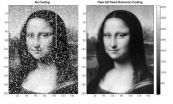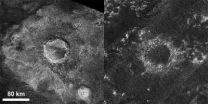(Press-News.org)
VIDEO:
NASA Goddard scientists transmitted an image of the Mona Lisa from Earth to the Lunar Reconnaissance Orbiter at the moon by piggybacking on laser pulses that routinely track the spacecraft.
HD...
Click here for more information.
As part of the first demonstration of laser communication with a satellite at the moon, scientists with NASA's Lunar Reconnaissance Orbiter (LRO) beamed an image of the Mona Lisa to the spacecraft from Earth.
The iconic image traveled nearly 240,000 miles in digital form from the Next Generation Satellite Laser Ranging (NGSLR) station at NASA's Goddard Space Flight Center in Greenbelt, Md., to the Lunar Orbiter Laser Altimeter (LOLA) instrument on the spacecraft. By transmitting the image piggyback on laser pulses that are routinely sent to track LOLA's position, the team achieved simultaneous laser communication and tracking.
"This is the first time anyone has achieved one-way laser communication at planetary distances," says LOLA's principal investigator, David Smith of the Massachusetts Institute of Technology. "In the near future, this type of simple laser communication might serve as a backup for the radio communication that satellites use. In the more distant future, it may allow communication at higher data rates than present radio links can provide."
Typically, satellites that go beyond Earth orbit use radio waves for tracking and communication. LRO is the only satellite in orbit around a body other than Earth to be tracked by laser as well.
"Because LRO is already set up to receive laser signals through the LOLA instrument, we had a unique opportunity to demonstrate one-way laser communication with a distant satellite," says Xiaoli Sun, a LOLA scientist at NASA Goddard and lead author of the Optics Express paper, posted online today, that describes the work.
Precise timing was the key to transmitting the image. Sun and colleagues divided the Mona Lisa image into an array of 152 pixels by 200 pixels. Every pixel was converted into a shade of gray, represented by a number between zero and 4,095. Each pixel was transmitted by a laser pulse, with the pulse being fired in one of 4,096 possible time slots during a brief time window allotted for laser tracking. The complete image was transmitted at a data rate of about 300 bits per second.
The laser pulses were received by LRO's LOLA instrument, which reconstructed the image based on the arrival times of the laser pulses from Earth. This was accomplished without interfering with LOLA's primary task of mapping the moon's elevation and terrain and NGSLR's primary task of tracking LRO.
The success of the laser transmission was verified by returning the image to Earth using the spacecraft's radio telemetry system.
Turbulence in Earth's atmosphere introduced transmission errors even when the sky was clear. To overcome these effects, Sun and colleagues employed Reed-Solomon coding, which is the same type of error-correction code commonly used in CDs and DVDs. The experiments also provided statistics on the signal fluctuations due to Earth's atmosphere.
"This pathfinding achievement sets the stage for the Lunar Laser Communications Demonstration (LLCD), a high data rate laser-communication demonstrations that will be a central feature of NASA's next moon mission, the Lunar Atmosphere and Dust Environment Explorer (LADEE)," says Goddard's Richard Vondrak, the LRO deputy project scientist.
The next step after LLCD is the Laser Communications Relay Demonstration (LCRD), NASA's first long-duration optical communications mission. LCRD will help develop concepts and deliver technologies applicable to near-Earth and deep-space communication.
INFORMATION:
NASA Goddard developed and manages the LRO mission and the LOLA instrument. The LRO mission is funded by NASA's Planetary Science Division in the Science Mission Directorate at NASA Headquarters in Washington. NGSLR is funded by the Earth Science Division at NASA Headquarters. LLCD is funded through a partnership with NASA's Space Communications and Navigation (SCaN) Program, and Science Mission Directorate. LCRD is funded through a partnership with SCaN and NASA's Office of the Chief Technologist.
NASA beams Mona Lisa to Lunar Reconnaissance Orbiter at the moon
2013-01-18
ELSE PRESS RELEASES FROM THIS DATE:
Titan gets a dune 'makeover'
2013-01-18
Titan's siblings must be jealous. While most of Saturn's moons display their ancient faces pockmarked by thousands of craters, Titan – Saturn's largest moon – may look much younger than it really is because its craters are getting erased. Dunes of exotic, hydrocarbon sand are slowly but steadily filling in its craters, according to new research using observations from NASA's Cassini spacecraft.
"Most of the Saturnian satellites – Titan's siblings – have thousands and thousands of craters on their surface. So far on Titan, of the 50 percent of the surface that we've seen ...
Stroke survivors with PTSD more likely to avoid treatment
2013-01-18
New York, NY — A new survey of stroke survivors has shown that those with post-traumatic stress disorder (PTSD) are less likely to adhere to treatment regimens that reduce the risk of an additional stroke. Researchers found that 65 percent of stroke survivors with PTSD failed to adhere to treatment, compared with 33 percent of those without PTSD. The survey also suggests that nonadherence in PTSD patients is partly explained by increased ambivalence toward medication. Among stroke survivors with PTSD, approximately one in three (38 percent) had concerns about their medications. ...
Severity of emphysema predicts mortality
2013-01-18
Severity of emphysema, as measured by computed tomography (CT), is a strong independent predictor of all-cause, cardiovascular, and respiratory mortality in ever-smokers with or without chronic obstructive pulmonary disease (COPD), according to a study from researchers in Norway. In patients with severe emphysema, airway wall thickness is also associated with mortality from respiratory causes.
"Ours is the first study to examine the relationship between degree of emphysema and mortality in a community-based sample and between airway wall thickness and mortality," said ...
Researchers find that simple blood test can help identify trauma patients at greatest risk of death
2013-01-18
SALT LAKE CITY – A simple, inexpensive blood test performed on trauma patients upon admission can help doctors easily identify patients at greatest risk of death, according to a new study by researchers at Intermountain Medical Center in Salt Lake City.
The Intermountain Medical Center research study of more than 9,500 patients discovered that some trauma patients are up to 58 times more likely to die than others, regardless of the severity of their original injuries.
Researchers say the study findings provide important insight into the long-term prognosis of trauma ...
UGA researchers invent new material for warm-white LEDs
2013-01-18
Athens, Ga. – Light emitting diodes, more commonly called LEDs, are known for their energy efficiency and durability, but the bluish, cold light of current white LEDs has precluded their widespread use for indoor lighting.
Now, University of Georgia scientists have fabricated what is thought to be the world's first LED that emits a warm white light using a single light emitting material, or phosphor, with a single emitting center for illumination. The material is described in detail in the current edition of the Nature Publishing Group journal "Light: Science and Applications."
"Right ...
Foreclosures in Florida on the Rise
2013-01-18
Foreclosures in Florida on the rise
The rate of foreclosures across the nation has dropped. RealtyTrac, a real-estate research group that studies foreclosures across the country, reports that the national rate dropped by 16 percent between September of 2011 and September of 2012. Unfortunately, the housing market in Florida is not following this trend.
According to the report, Florida continues to see high increases in foreclosure activity. The most recent statistic puts Florida at a 24 percent increase; resulting in the eleventh month in a row the state reported ...
Texas Supreme Court Clarifies Age Discrimination Law
2013-01-18
Texas Supreme Court Clarifies Age Discrimination Law
A south Texas school district secretary attempted to file an age discrimination claim earlier this summer, claiming that she was fired due to her age. However, the replacement employee was actually older by four years than the secretary herself. The secretary was 48-years-old at the time of her firing.
Texas law had not yet established whether an age discrimination case should be thrown out on the basis that a replacement employee is older than the employee who was terminated. Other jurisdictions have varied in ...
Refusing a DUI test in Connecticut
2013-01-18
Refusing a DUI test in Connecticut
It is important to know your rights if you are pulled over for a DUI. If an officer suspects you for driving under the influence, he or she can ask you take a blood, breath or urine test to determine your blood alcohol content. But you do have the option to refuse. You may wonder what happens if you refuse to take these tests.
Testing and arrest
An officer can ask you to take the test to determine your blood alcohol content if he or she has probable cause to think you are driving under the influence. Then, the test must be taken ...
How South Carolina Implied Consent Laws Work
2013-01-18
How South Carolina implied consent laws work
Anyone who has seen an episode of a popular crime drama knows that when you are being charged with a crime, you have the right to remain silent. But if you have been charged with a DUIin South Carolina, you do not have the right to refuse a breath, blood or urine test without penalty.
Implied consent laws in South Carolina
In South Carolina, people who are lawfully arrested for driving under the influence of alcohol are required to take a blood, urine or breath test when a law enforcement officer requests one. Generally, ...
Briefly Measuring the Pros and Cons of Business Entities: LLC or S-Corp
2013-01-18
Briefly measuring the pros and cons of business entities: LLC or S-Corp
Two of the most common business entities for small companies are the limited liability corporation and the S-Corp, but how do you know which entity is appropriate for your business? The answer may come down to cost, attraction of capital as your business grows, and tax considerations, among others.
To begin, the major advantage of filing either as an LLC or S-Corp is that both entities offer limited liability, which means the personal assets of the business owner are protected from the creditors ...

